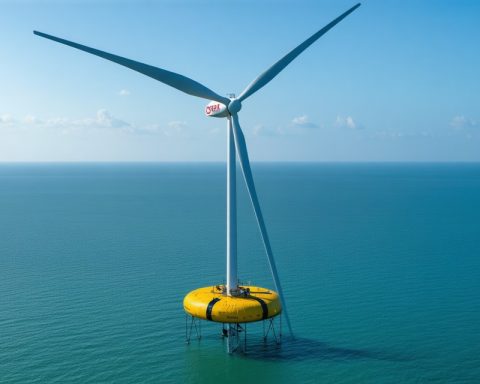- Beyond Aero, based in Toulouse, is advancing zero-emissions air travel with its hydrogen-powered jet, the BYA-1.
- The BYA-1 features a T-tailed, sleek design, using twin electric jets and strategically positioned hydrogen pods for efficiency and aesthetic appeal.
- Central to its innovation is a hydrogen-electric propulsion system utilizing six hydrogen cylinders and powerful fuel cells for a peak output of 3,217 horsepower.
- The aircraft promises quieter flights, up to 50% less noisy than traditional jets, while reducing operational costs by up to 55% and fuel costs by 17%.
- Beyond Aero has secured over $44 million in capital and 108 orders, demonstrating significant market interest and financial support.
- The company successfully conducted France’s first manned hydrogen-electric flight, marking a pivotal milestone in sustainable aviation.
- Collaborations with the European Aviation Safety Authority aim to achieve design approvals, targeting a launch by 2030.
Amid the bustling hub of Toulouse, a city renowned for its aviation heritage, a quiet yet sweeping revolution unfolds as Beyond Aero lays the groundwork for a new era of flight. Striving to redefine air travel with a vision that cuts through the dense fog of skepticism, this French company ambitiously charts the course for a zero-emissions future with its cutting-edge hydrogen-powered jet, the BYA-1.
Amidst a chorus of digital renderings, this ten-seat marvel promises more than just conceptual beauty. With its futuristic design, the BYA-1 stands at the intersection of engineering and artistry—a T-tailed, sleek form with twin electric jets and hydrogen pods nestled at its wingtips, a commendable feat of balancing practicality and aesthetic allure. Beyond its striking silhouette lies a critical mission: drastically reducing operational costs and noise pollution while boosting environmental sustainability.
Empowered by Hydrogen
At the heart of Beyond Aero’s innovation is the hydrogen-electric propulsion system, a paradigm shift from conventional jet engines. With zero emissions in mind, the aircraft is designed to run on six hydrogen cylinders tactically placed alongside the fuselage and wing tops. These feed powerful fuel cells responsible for converting hydrogen into electricity, which in turn powers electric ducted fans. The result? A potential peak output of 3,217 horsepower, enough to transport six passengers across 921 miles at altitudes of 26,000 feet with whispers of efficiency.
Flight routes spanning Europe might soon witness the BYA-1 gliding gracefully, spurred forward by hydrogen’s latent power. Hydrogen’s superiority in energy density compared to lithium batteries illuminates a path to sustainable aviation, albeit a challenging one. The complexity of integrating such an innovative powertrain into an airframe designed specifically for hydrogen storage is akin to weaving a delicate tapestry of cutting-edge technology and aerodynamics.
Reducing the Noise, Cost, and Carbon Footprint
The environmental benefits extend beyond emissions. The electric jets promise a whisper-quiet travel experience, potentially 50% quieter than traditional jets, enveloping passengers in a tranquil cocoon as they skim through the skies. Meanwhile, the economic allure of the BYA-1 is equally compelling. With operational costs slashed by up to 55% and fuel expenses potentially reduced by 17%, the financial and ecological savings present an undeniable appeal in a world seeking greener solutions.
Yet, turning renders into reality is a Herculean task, a challenge Beyond Aero readily accepts. Unlike many visionary yet short-lived endeavors, Beyond Aero can navigate these skies with a well-mapped course and a robust arsenal of over $44 million in capital and 108 committed orders worth $914 million. As a graduate of Y Combinator and a partner in the World Economic Forum’s First Movers Coalition, this isn’t the work of dreamers but doers with a roadmap and an unyielding resolve.
First Flights and the Journey Ahead
Their traction is not just theoretical. Pioneering France’s first manned hydrogen-electric flight with a G1 Aviation SPYL-XL ultralight serves as a tangible foundation for what lies ahead. Though rudimentary in presentation compared to the concept aircraft, this early prototype flight marks a significant milestone, proving the viability of their hydrogen propulsion system and cementing Beyond Aero’s place in the annals of aviation’s brave new world.
As the company files for design approvals and collaborates with the European Aviation Safety Authority (EASA), the journey to the skies of 2030 remains filled with turbulence. Yet, within Beyond Aero’s headquarters, a symphony of innovation plays undeterred by challenges—a testament to the belief that the skies, and perhaps the world, are ready for an aerodynamic renaissance powered by clean energy.
The Future of Aviation: Beyond Aero’s Hydrogen-Powered BYA-1 Jet Explained
Introduction
In the dynamic city of Toulouse, France, renowned for its rich aviation history, Beyond Aero is spearheading a revolution in air travel. The company is not just dreaming but actively creating a future where hydrogen-powered jets like the BYA-1 redefine the skies. Let’s delve into the unique features, potential benefits, and broader implications of this innovative aircraft, while exploring the questions that potential investors and enthusiasts might have.
Features and Specifications
1. Hydrogen-Electric Propulsion System: At the heart of the BYA-1 is a revolutionary hydrogen-electric propulsion system utilizing hydrogen cylinders to fuel electric jets via powerful fuel cells. This results in zero emissions, significantly reducing the aircraft’s environmental impact.
2. Design and Capacity: The BYA-1 features a sleek T-tailed design with twin electric jets and hydrogen pods. It’s designed to carry six passengers over a distance of 921 miles at a cruising altitude of 26,000 feet.
3. Performance and Efficiency: The hydrogen propulsion system can deliver up to 3,217 horsepower, promising a more sustainable and quieter flight compared to conventional jets.
Potential Benefits
– Environmental Impact: The zero-emissions design significantly cuts down the carbon footprint of air travel, contributing to global efforts to combat climate change.
– Cost-Efficiency: With operational costs potentially reduced by up to 55% and a 17% savings on fuel, the BYA-1 offers a financially viable alternative to traditional aircraft.
– Noise Reduction: The aircraft is 50% quieter than traditional jets, enhancing passenger comfort and reducing noise pollution.
Pressing Questions
How does hydrogen compare to other sustainable fuels?
Hydrogen offers higher energy density compared to lithium batteries, making it a more potent fuel for longer distances. However, challenges in storage and transportation still exist, though advancements are rapidly being made.
What are the current challenges?
Integrating a hydrogen propulsion system into an airframe requires specialized design considerations, such as safe storage for hydrogen. Furthermore, global infrastructure for hydrogen refueling is still in development.
What are the safety concerns?
Hydrogen is highly flammable, making storage and handling critical. However, advancements in safety technologies and stringent industry standards aim to mitigate potential risks.
Industry Trends and Market Forecasts
According to the International Air Transport Association (IATA), the demand for sustainable aviation solutions is expected to rise rapidly. By 2035, sustainable fuels like hydrogen could power up to 30% of airplanes as regulations tighten and consumer awareness increases.
Real-World Applications and Future Prospects
As more companies invest in hydrogen technology, the aviation industry is likely to see a shift towards cleaner fuels. The BYA-1 can serve niches in business and short-haul travel, setting a precedent for larger hydrogen-powered planes in the future.
Actionable Recommendations
For those in the aviation sector or potential investors:
– Stay Informed: Keep an eye on regulatory changes and advancements in hydrogen technology.
– Consider Investment: With Beyond Aero’s backing and market traction, investing in sustainable aviation technologies could be lucrative.
– Adopt Hybrid Models: Companies can bridge the gap by investing in hybrid models before transitioning fully to hydrogen.
Conclusion
Beyond Aero’s BYA-1 represents a new chapter in aviation, merging cutting-edge technology with sustainability goals. As the aviation community adapts, the BYA-1 could very well be the prototype that inspires future mainstream hydrogen-powered aircraft designs.
Suggested Links














